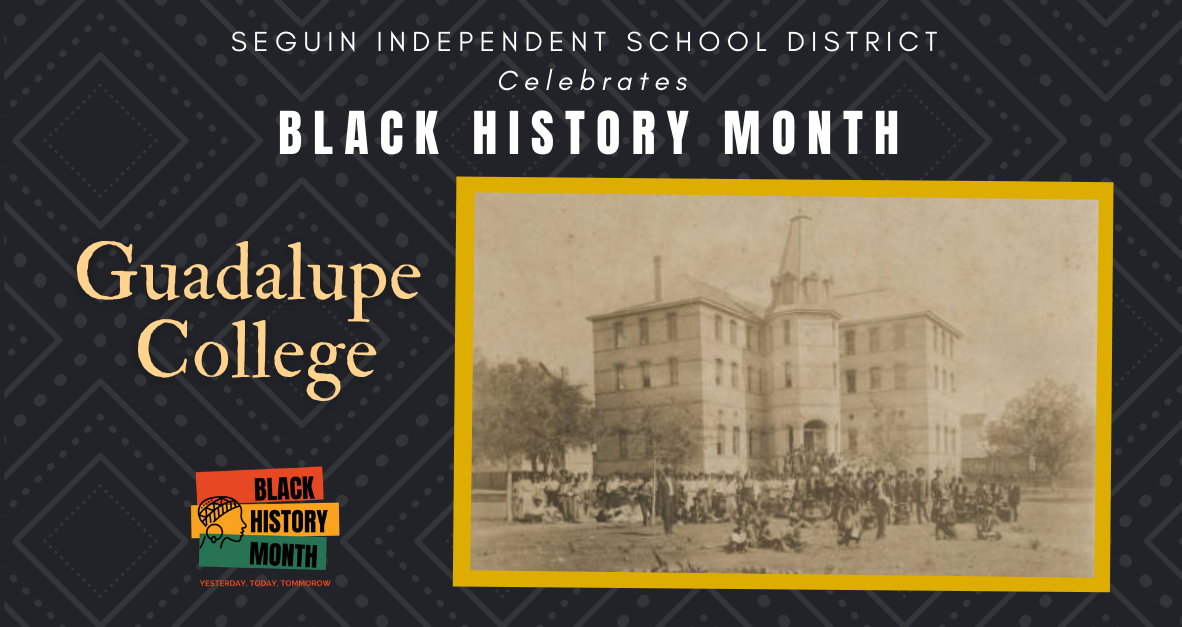
Guadalupe College (or College of the Guadalupe Baptist Association), an educational institution for African Americans located in Seguin, was founded in 1884 by members of the Guadalupe Baptist Association. This organization included Black Baptist congregations from Guadalupe and surrounding counties. Its leaders were Dr. William B. Ball, a Black Civil War veteran, minister, and school official who came to Seguin in 1871, and Rev. Leonard Ilsley, a White itinerant preacher. Trustees for the association purchased a large piece of property, three blocks west of the Guadalupe County Courthouse, that had been the site of several other schools. It is the present-day campus of Joe F. Saegert School.
The first official session of Guadalupe College opened in 1887 with J. H. Garnett as president. The state of Texas granted a charter to the institution on March 28, 1888. The purpose of the school was to awaken educational interest among the Blacks of Texas and to train teachers and religious leaders. Like White institutions of the time, the college department offered four years of classical courses, which led to a bachelor of arts degree. Other departments, designated as preparatory, primary, theological, musical, and industrial, offered a variety of courses and certificates. The State Board of Education endorsed Guadalupe College as a school of the first rank from 1902 until 1906; it was the only Black Baptist institution of higher learning in South Texas. Annual enrollment during the first 12 years averaged more than 200 and reached a high of more than 450 in 1907. Though students came from all over Texas, most were from Guadalupe County and surrounding areas.
Financial support of the college came primarily from Black Baptists, who contributed individually, through their district church associations, and through the statewide Baptist Missionary and Educational Convention. Philanthropist George W. Brackenridge of San Antonio donated generously to the operation and development of the college. His gifts included funds for a new chapel-auditorium and a valuable 216-acre tract on the Guadalupe River west of Seguin. To defray expenses, students maintained the grounds and buildings and built all new structures. The charter provided for a board of trustees to direct the school's affairs, although in practice the board-appointed president exercised extensive control. David Abner, Jr., a prominent Bishop College graduate active in church and Republican politics, succeeded Garnett as president in 1891. The college flourished during his 15 year tenure and attracted attention throughout the state.
Conflict with trustees forced Abner's resignation in 1906. His successor was W. B. Ball. Supporters of the school decided to begin anew and in 1914 moved the facility to the Guadalupe River farm property. Brackenridge, who favored expansion of the vocational program, contributed funds for construction of two modern brick buildings. The administration, convinced that a liberal arts education was more important, continued to maintain a traditional college department, as well as an academy and grammar school, with only incidental training in agriculture and trades. In keeping with the institution's religious orientation, students were required to give evidence of good moral character and to attend weekly prayer meetings and Sunday school. They also worked a specified number of hours each day for the college.
The Texas Department of Education classified Guadalupe College as a standard junior college in 1926 and accepted its credits in granting teacher certification. The institution was officially designated a senior college in May 1929. Presidents from 1921 until 1936 were Charles H. Griggs, F. G. S. Everett, and J. R. Lockett; attendance in the early 1930s averaged 60 in the college division and 125 in the academy.
Unfortunately for Black Baptists, the success of their school was short-lived. Hard-pressed financially by the Great Depression, Guadalupe College returned to junior college status in 1931 and suffered a fatal blow when fire destroyed the main building on February 9, 1936. Although the General Baptist Convention eventually built another building and conducted classes for ministers and lay leaders in the 1940s, efforts to reestablish a fully accredited college failed. The Texas secretary of state issued a new charter to the College of the Guadalupe Baptist Association in 1971, and alumni refurbished a wooden chapel to accommodate group meetings. No regular classes are conducted on the site, however.
Guadalupe College represented an important phase in the history of Black education, a phase dominated by the church-sponsored college. Its evolution, from a multipurpose facility offering instruction at all levels to an accredited college, paralleled closely with other Black institutions throughout the South. Guadalupe College contributed substantially to the advancement of African-American youth in South Texas. It offered educational opportunities superior to those provided to Blacks by public facilities, and it trained leaders for the Black community, particularly teachers and ministers. Most significantly, it fostered pride and self-respect.
Written by Anne Brawner for the Texas State Historical Association's Handbook of Texas